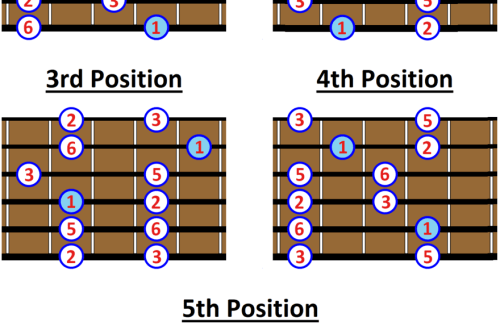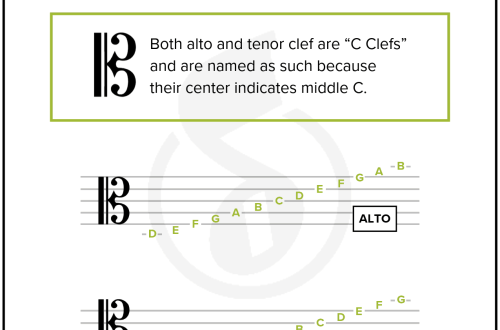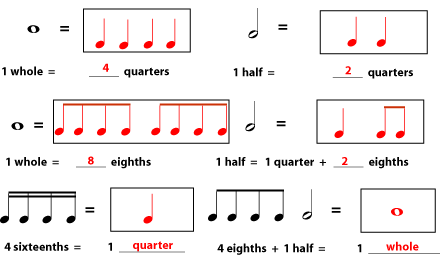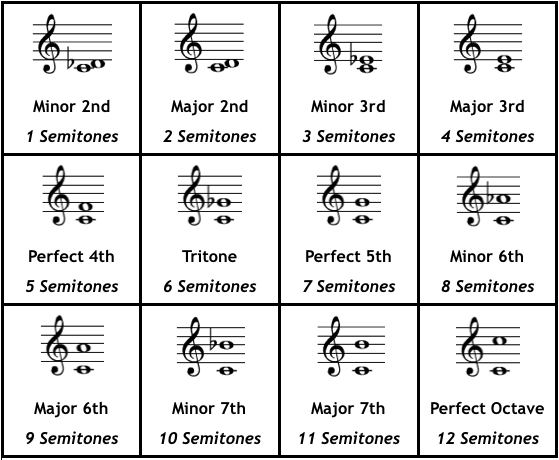
Musical intervals: what are they and how to build them?
Contents
Intervals in music are the distance between two sounds, and also the consonance of two notes. Here is a simple definition of this concept. At solfeggio lessons, they sing and listen to intervals, so that later they can be recognized in musical works, but first you need to learn how to build them from different notes.
There are only eight simple intervals, they are denoted by the usual numbers from 1 to 8, and are called special Latin words:
1 – receives 2 – second 3 – third 4 – quarter 5 – fifth 6 – sex 7 – septima 8 – octave
What do these names mean? Translated from Latin, prima is the first, second is the second, third is the third, etc.
Interesting facts about interval names
You have probably heard many of the interval names more than once, even if the conversation did not touch on music. For example, the word “receives” is in the phrase “diva” (this is the name of the first, that is, the main actress-singer of the theater).
Word “second” very similar to the English numeral «second» (that is, the second), and the name of the sixth interval “sex” looks like english «six» (six).
Interesting from this point of view are the intervals “septima” и “octave”. Remember how to say “September” and “October” in English? it «September» и «October»! That is, these names of months have the same roots as the names of intervals. “But after all, the seventh is seven, and the octave is eight, and the indicated months are the ninth and tenth in a year,” you say, and you will be absolutely right. The fact is that there were times when each new year was counted not from January, as it is now, but from March – the first spring month. If you count like this, then everything falls into place: September will be the seventh month, and October the eighth.
We have not yet said a word about the fourth and third. With the third, everything is clear – it just needs to be remembered, but especially observant ones will probably notice that if you read the word “tertiary”, skipping every second letter, you get an ordinary “three”.
In Russian there are words similar to “neighborhood”: this is, for example, an apartment or a quarter. What “neighborhood”? This word has two meanings: 1) division of the year into 4 equal parts; 2) a plot of urban development, which is surrounded by streets on four sides. One way or another, the number 4 appears here, and if you remember this association, then you will never confuse a quart with any other interval.
How to build intervals from different notes up and down?
Intervals are made up of two notes, which can be close or far apart. And about how far they are, we are told by the number of the interval by which it is indicated (from 1 to 8).
You know that every sound in music is a rung on a great musical ladder. So the number of the interval shows how many steps you need to go through in order to get from the first sound of the interval to the second. The larger the number, the wider the interval, and the further its sounds are from each other.
Let’s look at specific intervals:
Prima – denoted by the number 1, which tells us: two sounds are on the same level. So, prima is an ordinary repetition of a sound, a step in place: before and again before, or re and re, mi-mi, etc.

Second – is denoted by a deuce, because this interval already covers two steps: one sound is on any note, and the second is on the next, that is, the second step in a row. For example: do and re, re and mi, mi and fa, etc.
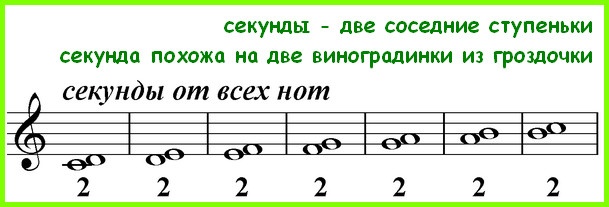
Third – spans three levels. The second sound is in relation to the first at a distance of three steps, if you go in a row along the musical ladder. Examples of thirds: do and mi, re and fa, mi and salt, etc.

Quart – now the interval is expanded to four steps, that is, the first sound is on the first step, and the second sound is on the fourth. For example: do and fa, re and salt, etc. Let us explain again that you can start counting steps from any note: at least from to, at least from re – we choose what we need.

Quint – the designation by the number 5 indicates that the width of the interval is 5 steps. For example: do and salt, re and la, mi and si, etc.

Sexta and Septima – the numbers 6 and 7, by which they are indicated, indicate that you need to count six or seven steps in order to get a sixth or a seventh. Examples of sixths: do and la, re and si, mi and do. Examples of sevenths (all up the stairs): do and si, re and do, mi and re.


Octave – the last interval, as easy as the prima. This is also a repetition of the sound, only at a different height. For example: up to the first octave and up to the second octave, re and re, mi and mi, etc.

And now let’s build all the intervals in order from the note TO and the note, for example, SALT. You can listen to examples. Do it!
Intervals from D to up

Intervals from G up

IMPORTANT! count steps and you can build intervals not only up, but also down. Look at the picture: here all eight intervals are built down from the notes C and A.
Intervals from note to down

Intervals from LA down

Exercises: playing intervals on the piano
When studying intervals, exercises on the piano or on a drawn keyboard are equally useful for both adults and children. A piano or a synthesizer with sound is, of course, better, because the goal of studying intervals on solfeggio is not to remember the name of the interval, not the notes that make it up (although this is also important), but the sound.
Therefore, if there is no suitable instrument at hand, then you can use the virtual keyboard or the Piano application on your phone (tablet). It is important that you work not in silent mode, but with sound (preferably).
Exercise 1. Playing prims
Prima is easy to play, because prima is the repetition of the same note twice. So, you just need to hit any key twice and you will already get an interval. Prima is a very important interval that occurs in many songs, so you should never forget about it (usually they forget because it is easy).
Exercise 2. Playing seconds
A second is always formed by two adjacent steps, two notes that are nearby. And on the piano keyboard, to play a second, you also need to take two adjacent keys. Play seconds from different notes – up and down, memorize the sound, you can also practice solfeggio in parallel, that is, sing the notes you play.
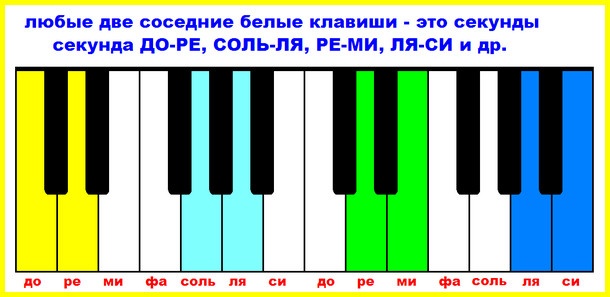
Exercise 3. Playing Thirds
Third is the favorite interval of little V.A. Mozart – the genius of world music. It is known that in childhood Mozart the kid approached his father’s harpsichord (the instrument is the forerunner of the piano), he did not see the keys (by height), but reached out to them with his hands. Mozart played all sorts of harmonies, but most of all he was happy when he managed to “catch” a third – this interval sounds so beautiful and melodious.
Try to play thirds and you. Take the “DO-MI” third and remember this distance: the sounds are located on the keyboard through one key (through one step). Play thirds up and down from different notes. Play the sounds of thirds at the same time or alternately, that is, at random.
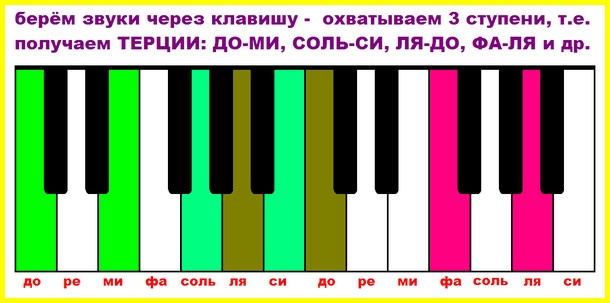
Exercise 4. Playing fourths and fifths
Fourths and fifths are intervals that sound militant, inviting and very solemn. No wonder our Russian anthem begins with a quarter. Take a fourth of “DO-FA” and a fifth of “DO-SOL”, compare them in sound, remember the distance. Play fourths and fifths from different notes. Try to learn to instantly find these intervals with your eyes on the keyboard.
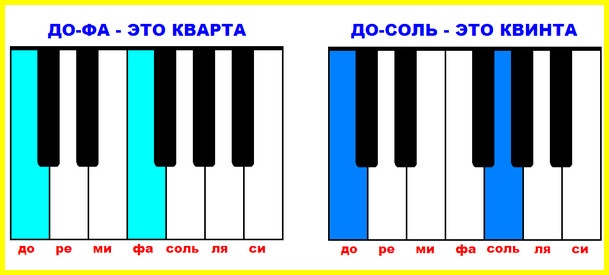
Exercise 5. Playing sixths
Sexts, like thirds, are also very melodic and beautiful in sound. To quickly play a sixth, you can mentally imagine a fifth (its number is 5) and add one more step to it (to make it 6). Play sixths up “DO-LA”, “RE-SI” and from all other notes and down “DO-MI”, “RE-FA”, etc.

Exercise 6. Playing octaves
An octave is the repetition of a sound in the next octave. Such a paradoxical and ridiculous definition can be given to this interval. Find two identical notes on the keyboard that are as close as possible: two DO (one in the first octave, the second in the second), or two PE. These will be octaves. That is, an octave is the distance from one sound to its repetition on the musical ladder. Octaves must be seen immediately. Practice.
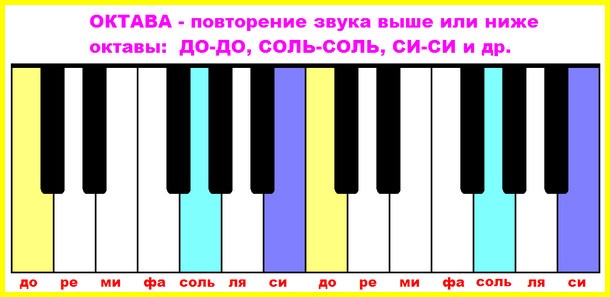
Exercise 7. Playing sevenths
We almost missed the seventh interval – the seventh. We want to share with you one trick. It is known that the number of the octave is 8, and the seventh is 7. So, to get the seventh, you just need to subtract one step from the octave. This is a way to quickly build a seventh, so as not to count seven steps “from the stove” each time.
For example: we need a seventh from PE. Imagine an octave – RE-RE, and now let’s lower the top sound by one step: we get the seventh RE-DO!
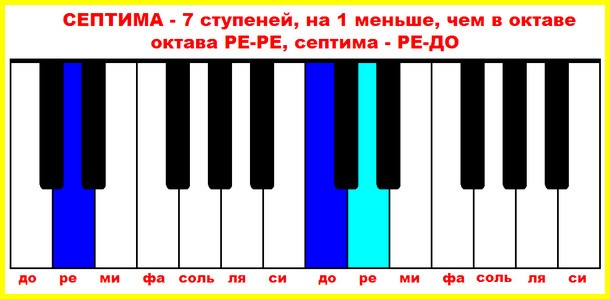
Another example: let’s build a seventh from MI down. We put down the octave – MI-MI, and now, attention, let’s raise the lower sound one step up and get the seventh MI-FA down. And why did we raise the lower sound, and not lower it? Because intervals built down are like a reflection in a mirror, and therefore all actions must be done in reverse.

Dear friends, if you have completed the proposed exercises, then you are just great! You have learned a lot, but this is only the beginning, the first acquaintance with intervals. Intervals in this form usually take place in grades 1-2 of music schools, and then everything gets a little more complicated. And we invite you to go for new knowledge with us.
In the following issues, you will learn about what is the quantitative and qualitative value of the interval, what are conversions and how you can get reduced and increased intervals. See you soon!



